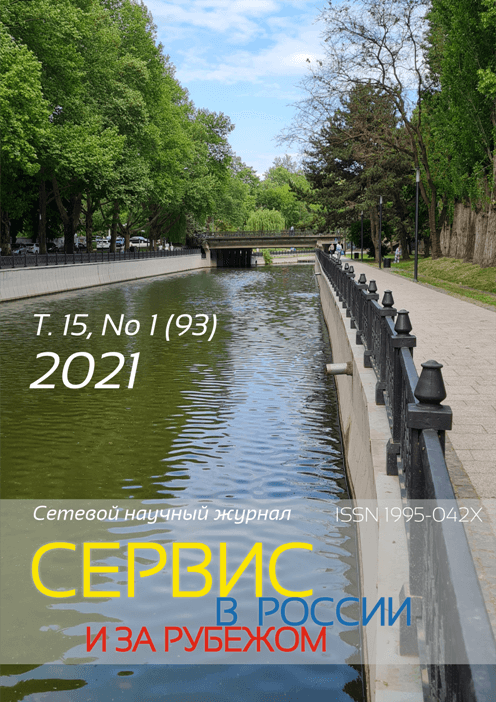Methodological approaches to the comparative assessment of the recreational and geographical location for the international tourism development (the case of China)
DOI:
https://doi.org/10.24412/1995-042X-2021-1-59-69Keywords:
recreation, tourism, recreational and geographical position, China, tourism and recreational potentialAbstract
The article presents the results of the assessing the recreational and geographical location of the regions of China. Recreational and geographical location is considered as part of tourism and recreational potential and an important condition for the international tourism development. The analysis of the spatial differentiation of tourist flows and their structure revealed the relationship among the recreational- geographical location and the peculiarities of the development of international tourism in the regions of China. To assess the recreational-geographical location, indicators were selected to meet the principles of openness and comprehensiveness. Based on the typological approach, the regions of mainland China are divided into 5 groups. The first two groups include regions with the most favorable recreational-geographical location for the international tourism development. The greatest advantages were identified for Guangdong, Shandong, Jiangsu, Shanghai, Zhejiang. Their advantages include location within the most economically developed part of the country, coastal, border and neighboring location, high transport accessibility, proximity to outbound tourism markets (Japan, Republic of Korea, Taiwan, Macao, Hong Kong). The next two groups of regions are characterized by a recreational and geographical situation combining favorable and unfavorable aspects. The regions of the 5th group (Gansu, Qinghai, Tibet, Ningxia-Hui Autonomous Region) have the least favorable recreational and geographical position. They are located within the most remote and least economically developed part of China, away from the seacoasts and outbound tourism markets; they are characterized by low transport availability. This weakens the tourist and recreational potential of the regions for the international tourism development. The patterns identified in the process of assessing the recreational and geographical location can be used to determine priorities in the tourism development and the formation of regional tourism policy.
Downloads
References
Кружалин В.И., Мироненко Н.С., Зигерн-Корн Н.В., Шабалина Н.В. География туризма. М.: Федеральное агентство по туризму, 2014. 336 с.
Баранский Н.Н. Экономико-географическое изучение городов // Вопросы географии. М.: Географгиз, 1946. №2. С. 19–62.
Афанасьев О.Е. Методика оценки туристско-рекреационных ресурсов зависимых стран и территорий мира // Сервис Plus. 2016. Т.10. №2. С.54–63.
Гудковских М.В. Методика комплексной оценки туристско-рекреационного потенциала // Географический вестник. 2017. №1(40). С. 102–116.
Дирин Д.А., Крупочкин Е.П., Голядкина Е.И. Методика комплексной оценки туристско-рекреационного потенциала региона // География и природопользование Сибири. 2014. №18. С. 64–78.
Дроздов А.В. Выявление, оценка и использование туристских ресурсов России. Современная ситуация, проблемы и пути их решения // Актуальные проблемы туризма: Сб. науч. тр. Российской международной академии туризма. Вып. 1. М.: Меркурий, 2007. С. 228–250.
Мамраева Д.Г., Ташенова Л.В. Методический инструментарий оценки туристско-рекреационного потенциала региона // Экономика региона. 2020. Т.16. Вып. 1. С. 127–140.
Сафарян А.А. Подходы к оценке туристского потенциала территории // Географический вестник. 2015. №1(32). С. 89–102.
Худеньких Ю.А. Подходы к оценке туристского потенциала территории на примере районов Пермского края // География и туризм: Сб. науч. тр. Пермь: ПГУ, 2006. С. 217–230.
Потапов И.А. Оценка транспортно-географического положения рекреационных объектов (на примере Соловецких островов) // Географический вестник. 2014. № 3 (30). С. 121–129.
Потапов И.А. Методические подходы анализа транспортно-географического положения рекреационных объектов Архангельской области // Сервис в России и за рубежом. 2016. Т.10. №4. С. 43–55.
Безруков Л.А., Дашпилов Ц.Б. Транспортно-географическое положение микрорегионов Сибири: методика и результаты оценки // География и природные ресурсы. 2010. №4. С. 5-13.
Дашпилов Ц.Б. Анализ транспортного воздействия на рекреационное развитие центральной экологической зоны Байкальской природной территории Иркутской области и его картографирование // Сервис в России и за рубежом. 2019. Т.13. Вып.3. С. 115–124.
Caldeira А., Kastenholz E. Spatiotemporal tourist behaviour in urban destinations: a framework of analysis. Tourism Geographies. 2019. Vol.22. Iss.2. Pp. 1–29.
Mohaved A., Gahlehteimouri K.J. The Importance of the Concept and Meaning of Place in Tourism Geography // Journal of Tourism, Hospitality and Environment Management. 2019. Vol.4. Iss.16. Pp. 1–9.
McElroy J.L., Lucas H. A note on the significance of geographic location in island studies // Island Studies Journal. 2014. Vol. 9. Iss.2. Pp. 363–366.
Rodrigue J.-P. The Geography of Transport Systems. New York: Routledge, 2020. 456 p.
Gushina M.V., Sazykin A.M. Comparison of spatial diferentiation of tourist attraction and recreational flows in China // Tourism and Hospitality Research (TOR-2013): 2nd Annual International Conference. Singapur, 2013. Pp. 83–86.
Downloads
Published
How to Cite
Issue
Section
License
Copyright (c) 2021 Sazykin, A. M., & Glushko, A. A.

This work is licensed under a Creative Commons Attribution-NonCommercial-ShareAlike 4.0 International License.












